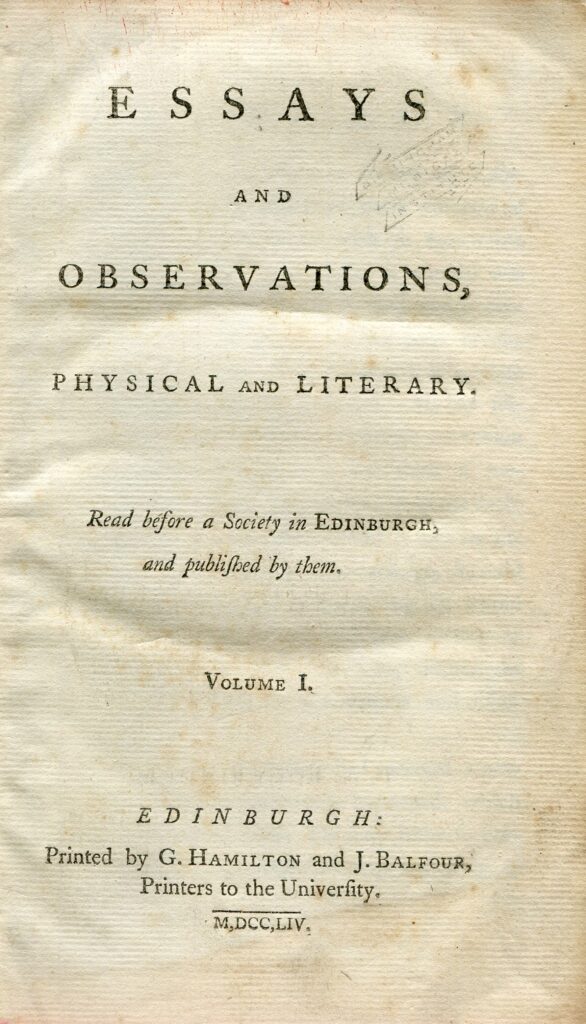All three volumes in first edition, very seldom found together. ‘The Philosophical Society (originally named the Medical Society) had published five volumes of Medical Essays and Observations between 1733 and 1744. Like many institutions of the day, it lapsed during the Jacobite Rebellion. However, at the instigation of Henry Home (later Lord Kames) it was revived about 1748. Hume and Adam Smith were recruited to play active roles. Hume and Dr Alexander Monro became the editors of the Essays and Observations’ (William Zachs, An exhibition at the Writers’ Museum commemorating the 300th anniversary of Hume’s birth, Edinburgh, 2011). The set contains 89 papers presented to the Society, including contributions by Charles Alston, Joseph Black, William Cullen, Colin Maclaurin, Thomas Melvill and John Stewart. The two last-named make brief but notable early responses to Hume’s philosophy: Stewart’s ‘Some Remarks on the Laws of Motion, and the Inertia of Matter’ (Vol. I) includes a critique of Hume’s views of causality and personal identity; and Melvill’s ‘Observations on Light and Colours’ (Vol. II) criticises Hume’s view of indivisible space in the Treatise 1.2. Volume III also contains a letter to Hume from Benjamin Franklin on lightning rods (pp. 129-40).
‘The preface to the first volume of the Essays and Observations signals Monro’s dominant editorial role in the new venture, for the wording of the preface echoes the account of the Society that appeared in the Medical Essays and Observations of 1742. Monro’s fellow Secretary, David Hume, probably helped to polish the prose, and he may also have been primarily responsible for the passage outlining the role of academies like the Society in the promotion of natural knowledge (Vol 1, pp v-vi) …
What then, do the three volumes of the Society’s Essays and Observations, Physical and Literary tell us about science and medicine in the Scottish Enlightenment? First, of the many clubs and societies that were formed in enlightenment Scotland, the Edinburgh Philosophical Society was among the most durable and long-lasting, rivalled only by the Edinburgh Musical Society and Royal Medical Society. The fact that two of these three societies were devoted to science and medicine indicates that the pursuit of natural and medical knowledge was a basic component of enlightened culture in eighteenth-century Scotland. Secondly, the list of contributors to the Essays and Observations underlines the point that the Scottish Enlightenment was firmly rooted in the universities, and that the Edinburgh medical school consolidated Scotland’s place in the republic of learning, because it both fostered the growth of an extensive communications network through its graduates and acted as a stimulus for the study of the sciences more generally. Thirdly, the contributions to the Essays and Observations show that the Scots were simultaneously cosmopolitan in outlook and attentive to their own local circumstances. While the problems they addressed and theories they debated were common to enlightened savants throughout the Atlantic world, their work was at the same time couched in their own distinctive intellectual idioms, and their attempts to apply their knowledge and expertise in the sphere of economic improvement were shaped by local priorities. Fourthly, many of the medical reports contained in Essays and Observations are symptomatic of the increasingly empirical tenor of medicine in the eighteenth century, which manifested itself in the growing importance of detailed descriptions of clinical cases and the compilation of comparative data on diseases and treatments. Lastly, the Essays and Observations attest to the vitality of Scottish scientific and medical thought in the Enlightenment. Whereas the generation of virtuosi led by Sir Robert Sibbald may have been motivated to improve Scottish culture because of their sense of shame at Scotland’s comparative backwardness, the generation of savants that included William Cullen and David Hume were satisfied, to paraphrase Hume, that they lived in a scientific and medical age and that Scotland was the scientific and medical nation’ (Paul Wood, ‘Introduction’ to the Thoemmes Press reprint, 2002).

